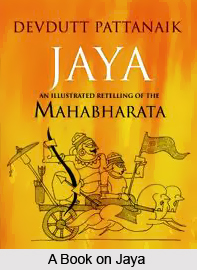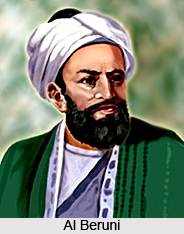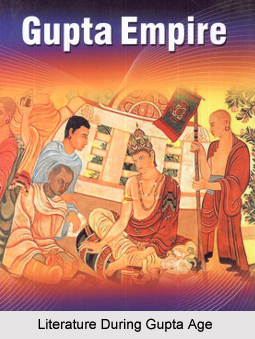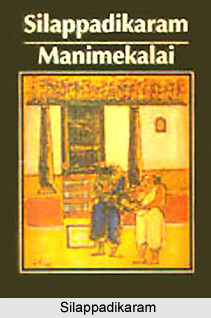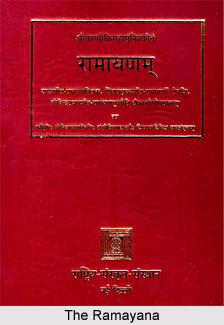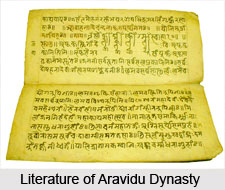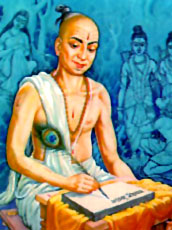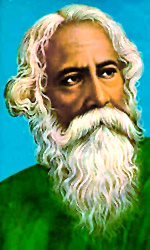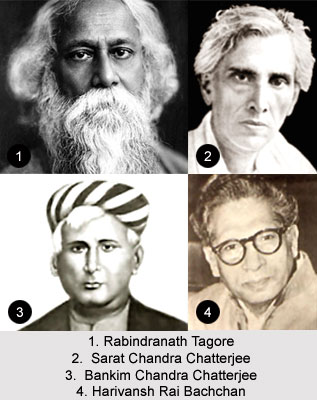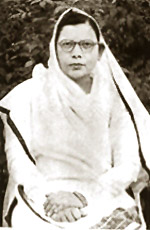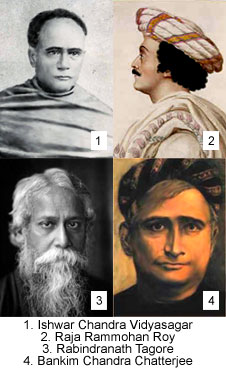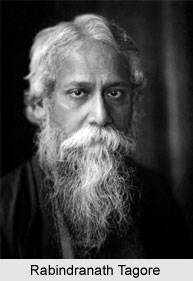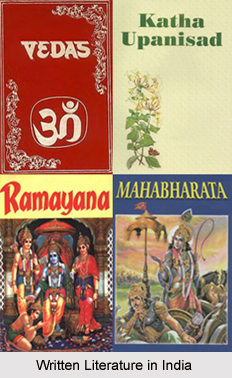 Indian literature incorporates perhaps the most bulky, most gigantic, most enormous and most intellectual of the concepts ever to have been established in any genre in literature across the world. Since its very inception, literature in India has been accepted as an inseparable part of daily life, even though `literature` did not entirely take up its present form, or even did not possess that strict name of `literature`, as can comprehended from ancient history of India. Indeed, the history of India and the country`s gradual evolution into modernity, metamorphosing from ancientness, be it with any ruling empire or dynasty or culture, was invariably linked with literary evolution and literary styles. After checking through the historical annals, it can verily be established that Indian literature is perhaps the only genre that was affected to the core, that too profoundly, forever accepting its changes with every changing scenario from prehistoric and unrecorded times. In this most inspiring and challenging a setting, literature in India had first budded forth in the oral format, through the word of mouth. Oral literature was smoothly declared and accepted with open hands, without the sophistication of paper and the printing press. However, orality was later eclipsed by written literature in India, which had truly brought in a massive, colossal, striking and most extraordinary a wave of modernity, taking up the Indian population by storm. Composers, authors, poets, dramatists or novelists in the literary genre, also including every other writer (mathematicians, astrologers, astronomers, meteorologists, historians, theologians. etc) during ancient India, felt the warmth of the tremendous attraction of writing down in paper or in any decorative book, perhaps only to gain popularity or royal patronage. Written literature in India was successful almost to overshadow oral literature, due to its reasons that they could forever be captured under documentation, certification, or registration. Prehistoric India, or India during Vedic Age, was entirely dominated by Hinduism and Hindu religious, yet another majestic reason for Indian written literature to be accepted, sometimes also under complete command from Hindu upper-class priests or societal élite. Indeed, Hinduism and its several religious doctrines were penned in out-and-out scholastic Sanskrit language, the language of the `exclusives` and the `fortunates`.
Indian literature incorporates perhaps the most bulky, most gigantic, most enormous and most intellectual of the concepts ever to have been established in any genre in literature across the world. Since its very inception, literature in India has been accepted as an inseparable part of daily life, even though `literature` did not entirely take up its present form, or even did not possess that strict name of `literature`, as can comprehended from ancient history of India. Indeed, the history of India and the country`s gradual evolution into modernity, metamorphosing from ancientness, be it with any ruling empire or dynasty or culture, was invariably linked with literary evolution and literary styles. After checking through the historical annals, it can verily be established that Indian literature is perhaps the only genre that was affected to the core, that too profoundly, forever accepting its changes with every changing scenario from prehistoric and unrecorded times. In this most inspiring and challenging a setting, literature in India had first budded forth in the oral format, through the word of mouth. Oral literature was smoothly declared and accepted with open hands, without the sophistication of paper and the printing press. However, orality was later eclipsed by written literature in India, which had truly brought in a massive, colossal, striking and most extraordinary a wave of modernity, taking up the Indian population by storm. Composers, authors, poets, dramatists or novelists in the literary genre, also including every other writer (mathematicians, astrologers, astronomers, meteorologists, historians, theologians. etc) during ancient India, felt the warmth of the tremendous attraction of writing down in paper or in any decorative book, perhaps only to gain popularity or royal patronage. Written literature in India was successful almost to overshadow oral literature, due to its reasons that they could forever be captured under documentation, certification, or registration. Prehistoric India, or India during Vedic Age, was entirely dominated by Hinduism and Hindu religious, yet another majestic reason for Indian written literature to be accepted, sometimes also under complete command from Hindu upper-class priests or societal élite. Indeed, Hinduism and its several religious doctrines were penned in out-and-out scholastic Sanskrit language, the language of the `exclusives` and the `fortunates`.
As has been mentioned earlier, the literary tradition in India was basically oral literature in the vernacular languages, which can be stated as the precursor of written literature in India, owing to its sheer capacity to contain almost everything, poetry, drama or novel. This oral format was handed down from generation to generation without any concern for manuscripts and were also for the most part sung or recited. It was only in the 16th century that an extensive written literature alighted upon the Indian scenario. This gradual change, however, possesses its own ground of authenticity. The reason behind such metamorphoses was the overwhelming literary predominance of Sanskrit and the emergence of Hindu pietistic movements that had zealously attempted to reach out the mass in their everyday languages. Excluding south India and its inhabitants, where a vast literature in Tamil language was being rendered novel life from ancient times, consequent to which, south India, with its Dravidian group of languages, have been still successful to maintain a perfect equipoise between orality and writing literature. Previously, during the Vedic times, Sanskrit language and its literature was a target only for the Brahmins and as a result, only a handful could achieve proper education in the oral or written manner. The most ancient forms of written literature in India were downright `religious` and `spiritual`. Indian written literature in its most preliminary stage comprised the Vedas (Rig Veda, Yajur Veda, Sama Veda, Atharva Veda), the Brahmanas, the Aryankas, the Upanishads, the Samhitas, the Sanskrit epics - Ramayana and Mahabharata, the Brahmashastras, the mythological writings acknowledged as Puranas. The literature from this era were penned in the mother language of Sanskrit, together with its later progenies, Pali and Prakrit languages.
While the history of the maturation and evolution of each of the Indian languages is not known to the particulars, most written literature in India appear to have acquired its characteristic tone in the past thousand years. The ancient Sanskrit script is possibly not older than two thousand and five hundred years. Texts and manuscripts in different languages and in Sanskrit are in the process of incessant and unceasing discovery and restoration, furthering an individual`s awareness about the history and culture of Indian civilisation. It was precisely during this ancient literary period in India, that the basic Indian written literatures made their appearance, comprising - Indian drama, Indian poetry and Indian novels. Indeed, these three cardinal genres had already been almost formulated in the times of existence of oral literature. However, drama, poetry and novel received its impressive thrust and push during the transition from orality to writing, when they began to be penned on paper and were considerably patronaged by the ruling emperors and their dynasties. It can assuredly be stated that royal backing and showering of benefaction was the most principal cause for written literature in India to survive wholly, that too in a mind-blowing manner! Speaking about royal patronage, the Islamic rulers were perhaps the most striking in demonstrating their patronage and sponsoring with any kind of humanly-possible assistance. Amongst the Muslim writers and their advancement, classical Persian poetry was the significant source of a later growth in Urdu literature produced for the Mughal court and intricate Urdu verse on established themes were giving birth to prolific literary wonders.
With the culmination of Islamic rule, India had to go through its most shocking and reeling phase of the British Raj, wherein literature also looked towards a dichotomous kind of situation; colonial rule, on the one hand had instilled some benevolence on their part, which was almost completely eclipsed by their ruthlessness and cruelty. However, written literature in India was one arena, which perhaps was the least affected in worse terms, only looking towards brightness. The British men, often with able assistance from the new wave of young Indian writers, had begun to bring into vogue the concept of English literature, spread of renaissance or taking vernacular education to every class of household through establishment of primary schools, colleges and universities. During the early 19th century, with the founding of vernacular schools and the importing of printing presses, a great impetus was lent to `popular prose`, with Bengali authors taking the lead. Foreign, particularly English, literature was willingly studied and researched and to some extent absorbed within the classical Indian styles and themes. Indeed, Bengali writers, their extent and limit of stretching themselves in terms capability and the end product that came up, still are quoted in terms of extreme extolment. Written literature in India perhaps never had received such an enthusiastic response, as was witnessed through the new generation of Bengali writers, pledged with the cult of renaissance and making India a better place to live. It was precisely during the British Raj, that Translation work in Indian literature had become a rage and widely-admired trend, due to English yet to comprehended as a mass language and its usage. So men like Raja Rammohan Roy, Michael Madhusudan Dutt and Rabindranath Tagore and Ishwar Chandra Vidyasagar from Bengal had fought till death to make English works be accepted in the pan Indian scenario. As such translation works from English to other vernacular languages had made the transition much smoother.
Holding hands and coming gradually down the ancestral lineage of Indian written literature, the pre-Independence domain also had remained witness to an astounding popularity of children`s literature amongst every Indian societal class. Children`s literature in India, was not entirely an alien concept though; it perhaps had remained inert in existence since ancient times. The colonial literary period remained perfect witness to its tremendous admirability. However, India gained its Independence after incredible crusades and bloodshed, thus ending a significant era of colonialism, which perhaps had forever left its indelible impact upon Indian literature. Written literature in India was no longer just restricted to India only, the country was divided into Pakistan and Bangladesh, with writers and their religions also being separated forever. As such, literary genres began to spring up, with novel and challenging themes as their basic groundwork. Indian English Literature was perhaps the foremost to come up as that innovative genre, under the era of post-colonialism. Writers in this sphere still teems with intellectuality and brilliance, taking written literature in India towards great heights. Literature in English, in order to reach to common masses, had intended to reach all the university-educated public, irrespective of vernacular language. Among the most-admired writers of the 19th and early 20th century, Raja Rammohan Roy, Bankim Chandra Chattopadhay, Swami Vivekananda, Rabindranath Tagore - winner of the 1913 Nobel Prize in Literature and Munshi Prem Chand, as well as Asadullah Khan Ghalib and Muhammad Iqbal, the Muslim poets who wrote in Urdu and in Persian, all are still counted in the most elite list of Indian written literature. Later writers include R. K. Narayan, Raja Rao, Bhabani Bhattacharya, Ahmed Ali, Khushwant Singh, Thakazhi Sivasankara Pillai, and Mulk Raj Anand in the field of fiction; Sarojini Naidu, Faiz Ahmed Faiz, and Kazi Nazrul Islam, in the field of poetry; and Mahatma Gandhi, M. N. Roy, Jawaharlal Nehru, and Jaya Prakash Narayan in the field of politics.
The contemporary Indian panorama of written literature, has reached to such extent and scope, that perhaps every class, society and community possess a literary genre of there own. Indian vernacular literatures have lent a particular cutting competition to international literary state of affairs, that Indian literature in English and others have been successful enough to defeat several other literary luminaries. Even the once referred to as backward classes, the tribal society, the almost incommunicado, have also begun to branch out since long. The tribal society, in any form of North-eastern India, or central India, do possess their own bulk literature, making Indian tribal literature scale peak heights, even winning prestigious awards both within the country and abroad.
